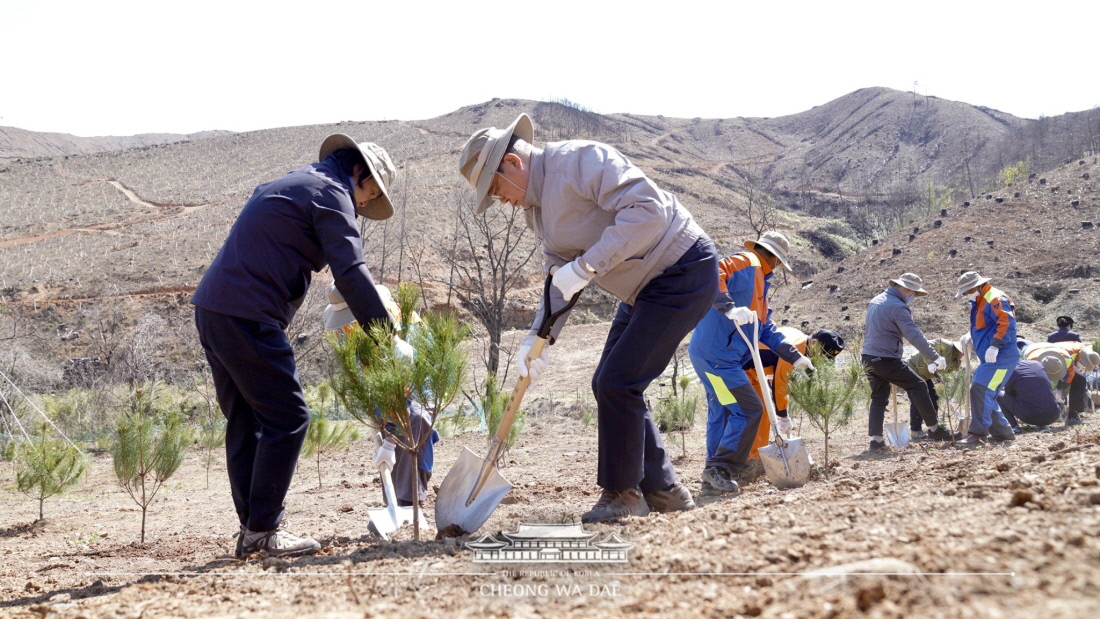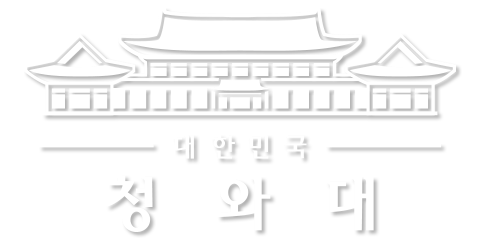이 웹사이트는 제19대 대통령 임기 종료에 따라 대통령기록관이 「대통령기록물 관리에 관한 법률」에 의해 이관받아 서비스하는 대통령기록물입니다. 자료의 열람만 가능하며 수정 · 추가 · 삭제는 불가능합니다.
다만, 「개인정보보호법」에 의하여 개인의 정보를 보호받기 원하시는 분은 관련 내용(요청자, 요청내용, 연락처, 글위치)을 대통령 웹기록물 담당자(044-211-2253)에게 요청해 주시면 신속히 검토하여 조치해 드리겠습니다. 감사합니다.
SPEECHES & REMARKS
BRIEFINGS

I am glad to meet you all. Gangneung’s Okgye-myeon suffered the greatest damage from the Gangwon-do Province wildfires last year. My heart is truly filled with emotions as I’ve come here again to personally see how the area is being restored and participate in reforestation work with you.
Do you happen to know that Korea ranks fourth in terms of the percentage of territory covered in forests among the OECD member states? Korea is the OECD’s fourth largest forest power, following Finland, Sweden and Japan, with 63 percent of its entire territory actually covered with trees, not simply the area designated as forest land. Korea’s growing stock per hectare – the total amount of forest trees – is also near the top among the OECD member states. This is an achievement our people have accomplished over the past 70 years.
In 1946, even before the Republic of Korea Government was established, April 5 was designated Arbor Day. Going further, Arbor Day was made into a public holiday in 1949 with the intention of helping the people spend the day on nothing but planting trees. It was not until after the adoption of the five-day workweek that Arbor Day ceased to be a public holiday. For such a long time, almost 60 years, our people planted trees every year without interruption. As a result, the bare hills that had been ravaged after suffering colonial rule and the Korean War were rapidly turned into lush mountains. Korea became the only country to succeed at reforestation to such an extent. For this reason, countries around the world see Korea as the most exemplary nation in mountain reforestation. Our people deserve to take pride in this fact.
Korea’s emergence as a prime example of reforestation has led many countries to ask for international cooperation on reforestation. As a result, we are also standing in a leading position, so to speak, with regard to international cooperation in forestry as well.
As you are aware, the Republic of Korea has carried out numerous forestation projects in northern China and Mongolia to prevent desertification and yellow dust. In Central Asia and the Mekong region, our country is engaging in forestry cooperation with the aim of helping to maintain cross-border peace. These are achievements in which our people can take great pride.
That said, as to the question of whether Korea is now an advanced country in terms of forestry, the answer is that our country is a “half advanced” nation. In terms of quantity, it can be regarded as an advanced country. But in terms of quality, it still imports a considerable amount of pulp and timber. As the country had rushed forestation, it mainly planted fast-growing trees – pitch pines, alder, acacia and aspen – instead of considering the economic return. In a sense, our trees are slightly lacking in economic value.
Therefore, from now on, our forest policy needs to focus on creating forests that comprise trees with economic value that can yield timber or fruit, rather than planting fast-growing trees. In addition, it is also necessary to build scenic forests suitable for tourism, fine dust-blocking forests that help reduce fine dust in urban areas along with other types of urban forests later on and fire-resistant forests in areas highly prone to wildfires. Now is the time to change the paradigm of our forest policy in this way.
Besides, tending to forests has now become as important as planting trees. Last year, the wildfires in Gangwon-do instantly destroyed dense forests, ten times the size of Yeouido. In Okgye-myeon alone, a forest about four times the size of Yeouido vanished. We need to recover them as early as possible.
As the Minister of the Korea Forest Service said just before, we will devise various short-term measures to prevent forest fires going forward and countermeasures to put out fires as soon as possible when they occur. At the same time, between this year and 2022, we will completely recover all the forests destroyed by fire through reforestation at the earliest possible date. Our goal is to restore half within this year.
Although we are now engaging in social distancing due to the COVID-19 outbreak, I would like to say that we should unceasingly carry on with tree planting and reforestation at this time. The people are suffering a lot from the COVID-19 outbreak, but I am also calling on them to actively participate in reforestation in such a manner as each person cultivating a tree or donating one.
The Geumgang pines that we are planting today are the best variety of pines, our people’s favorite tree. They grow tall and upright like this and are considered the best timber because of their very good quality. As all of the palaces and temples were built from Geumgang pines in the past, heavy punishments were imposed on anyone who cut them during the Joseon period. Even today, an owner of a mountain can be punished for recklessly cutting a Geumgang pine. These trees are protected in this way and have a high economic value.
Along with all of you, this group of reforestation workers, I am very pleased to participate in the reforestation work today together with Okgye residents. I hope that each and every tree that we are about to plant will be a start – that it will make the areas severely devastated by wildfires in Gangwon-do and the Okgye area in Gangneung green again and develop our country into a forest powerhouse.
Thank you.



